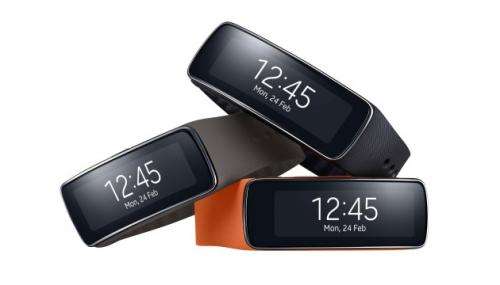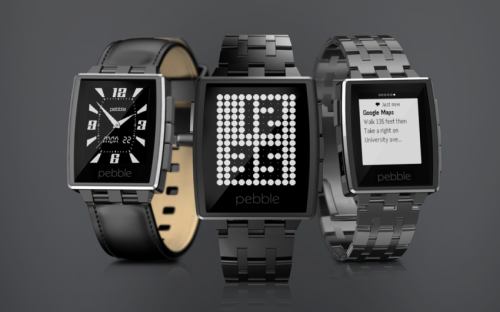Review: Smart watches show promise, but need work

If you believe the technorati, one of the next big things in consumer electronics will be smart watches. After testing a pair of prominent new smart watches in recent weeks, my quick take is this: Smart watches need a lot more refining before they become compelling products for mainstream consumers.
Smart watches are wrist-worn devices that not only display the time, but also can interact with applications, alert you when your phone rings or notify you of an upcoming meeting.
Although they have their own processors and sometimes include sensors and full operating systems, smart watches are designed to be accessories to smartphones and rely on the phones for their connection to the Internet, location information and often apps.
Despite these common features, smart watches have a lot of variation. There are no standards yet for what a smart watch should look like, what kind of screen it should have or how it should work.
Pebble's Steel and Samsung's Gear Fit show the range of smart watches now on the market. Their differences are obvious even before you strap them on.
The Steel has a flat, squarish, low-resolution, black-and-white display, while the Gear Fit has an elongated, high-resolution, full-color screen that's curved to wrap around a user's wrist. While the Steel's display is always on, the Gear Fit's is typically turned off and only lights up when the wearer presses a button or raises the watch close to his or her face.
The two watches also function differently. The Gear Fit has a touch screen like that on most smartphones. To access particular features or apps, you swipe up or down or tap on-screen buttons. By contrast, you interact with the Steel using one of four buttons on its sides.
Both watches allow you to interact with apps in different ways. In some cases, they display notifications from your smartphone, such as when you get a phone call or when one of your friends updates their status on Facebook. In other cases, they simply display data transmitted by particular smartphone apps. When you run a fitness app on your phone, for example, your smart watch might display how long and how far you've walked.
Both smart watches let you control some apps. You can pause or play your music app or fast forward to the next song using the buttons on Steel or the Gear Fit. And in some cases, full or partial versions of apps will run on the smart watches themselves. Both devices, for example, have pedometer apps that can run even when the smart watches aren't connected to their companion phones, and the Steel has a mini version of Yelp that can help users find nearby restaurants without pulling out their smartphone.

But even here there are distinctions. At least right now, you'll find a lot more apps that work with the Steel than with the Gear Fit. Pebble's new device runs the same operating system as Pebble's original smart watch, which debuted last year, and is compatible with all of the 2,000 or so apps that have been designed to work with that device.
By contrast, you'll only find about three dozen apps that work with the Gear Fit, although Samsung representatives say more should be coming soon.
To be sure, even with the Pebble watches, you may find that the apps you use regularly aren't compatible or offer only limited features. I couldn't use the Pebble to ask my dog walking app to start or stop tracking my excursion, for example. And you can't use the built-in music controllers on either device to search for particular songs or artists.
The Gear Fit offers one feature that the Pebble lacks: a built-in heart-rate monitor. You can use this to check your heart rate while at rest or have it continuously monitor you while you exercise.
Each device has its strong points and weaknesses. I liked the much wider array of apps for the Steel, like finding out the time by just glancing at it, and that it works with the iPhone and a wide array of Android devices. But using its non-touch-enabled, monochromatic screen felt like taking a step back in time.
By contrast, I loved the beautiful screen on the Gear Fit, and its touch-screen control was much more intuitive than the Steel's.
But I didn't like that it's only compatible with Samsung smartphones and tablets or that its screen was normally turned off, and it was frustrating trying to figure out the exact gesture required to turn it back on.
But both devices need polish. In my tests, neither lasted more than two days without needing a charge - even with light use. They both would be more useful if they could interact with more apps. And neither seems to have a killer app, a feature so compelling that people would clamor to buy it.
PEBBLE STEEL SMART WATCH:
-Troy's rating: 6.5 (out of 10)
-Likes: Always-on display; wide variety and sizable number of compatible apps; can be used as a pedometer even when disconnected from smartphone; water resistant to 120 feet; compatible with iPhone and Android smartphones.
-Dislikes: Only stores eight native applications at any one time; low-resolution, monochromatic display; lacks a touch screen, so interaction depends on physical buttons; small screen can only display limited information; is incompatible with many popular apps; relatively short battery life; significantly drains battery of paired smartphone.
-Price: $230
-Web: getpebble.com
SAMSUNG GEAR FIT SMART WATCH:
-Troy's rating: 6.0 (out of 10)
-Likes: Beautiful high-resolution full-color display; touch-screen interface; curved, elongated screen curves around the wrist to display more information; built-in heart rate monitor can keep track of your vitals while you exercise; can configure the screen to display information in portrait or landscape orientation; dust and water resistant.
-Dislikes: Display is turned off by default and only turns on with the press of a button or by executing an awkward and hard-to-master gesture; only compatible with Samsung smartphones; small number and range of compatible apps; short battery life; significantly drains battery of paired smartphone.
-Price: $200
-Web: samsung.com
©2014 San Jose Mercury News
Distributed by MCT Information Services


















